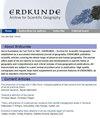Water crisis in the Eastern Hindu Kush: a micro-level study of community-based irrigation water management in the mountain village Kushum, Pakistan
IF 1.1
4区 社会学
Q3 GEOGRAPHY
引用次数: 3
Abstract
Irrigation water scarcity is a rapidly growing problem in the Hindu Kush-Karakorum-Himalayan region. Water is depleting and becoming scarce around the world due to a lack of integrated water management. Researchers have focused on sophisticated irrigation water management systems as an integral strategy to address water scarcity. However, rapid population growth, climate variability, and changes in mountain regions are exerting increasing pressure on water resources. To cope with water scarcity situations, local communities have developed sustainable management mechanisms throughout the mountain regions of the world. These practices are considered as adaptive strategies to address scarcity situations. This article aims to explore the multi-stage, spatio-temporal indigenous appropriation mechanisms of irrigation water and to analyze the seasonal variation in water entitlements in a semi-arid mountain milieu, i.e., Kushum-Chitral. This study is based on a decade of research conducted in the study area. Data were collected in four phases from 2010 to 2018. The study indicates that the share of co-owners has decreased substantially over time due to demographic development and climate change but does not always lead to the tragedy of commons. The study reveals that the local communities have the capacity and capability to sustainably manage an important and scarce resource – i.e., irrigation water – without external intervention.兴都库什东部的水危机:巴基斯坦Kushum山村社区灌溉水管理的微观研究
灌溉缺水是兴都库什-喀喇昆仑-喜马拉雅地区一个迅速增长的问题。由于缺乏综合水资源管理,世界各地的水资源正在枯竭和匮乏。研究人员将重点放在复杂的灌溉水管理系统上,将其作为解决缺水问题的整体战略。然而,人口的快速增长、气候变化和山区的变化正在给水资源带来越来越大的压力。为了应对缺水情况,当地社区在世界各地山区建立了可持续管理机制。这些做法被认为是解决稀缺情况的适应性战略。本文旨在探索灌溉水的多阶段、时空本地分配机制,并分析半干旱山区环境(即Kushum-Chitral)中水权的季节变化。本研究基于在研究领域进行的十年研究。从2010年到2018年,数据分四个阶段收集。研究表明,由于人口发展和气候变化,共有人的比例随着时间的推移大幅下降,但并不总是导致公地悲剧。研究表明,当地社区有能力在没有外部干预的情况下可持续地管理一种重要而稀缺的资源,即灌溉水。
本文章由计算机程序翻译,如有差异,请以英文原文为准。
求助全文
约1分钟内获得全文
求助全文
来源期刊

Erdkunde
地学-自然地理
CiteScore
2.00
自引率
7.10%
发文量
17
审稿时长
>12 weeks
期刊介绍:
Since foundation by Carl Troll in 1947, ''ERDKUNDE – Archive for Scientific Geography'' has established as a successful international journal of geography. ERDKUNDE publishes scientific articles covering the whole range of physical and human geography. The journal offers state of the art reports on recent trends and developments in specific fields of geography and comprehensive and critical reviews of new geographical publications. All manuscripts are subject to a peer-review procedure prior to publication. High quality cartography and regular large sized supplements are prominent features of ERDKUNDE, as well as standard coloured figures.
 求助内容:
求助内容: 应助结果提醒方式:
应助结果提醒方式:


